VIKRUTI NAAMA UGAADI 2010
Posted in General
MUGGU drawing Competition in MAURITIUS-2010
MUGGU MAHOTSAVAALU
Muggu( in Telugu) is a decorative design drawn using rice, pulses and rice powder by female members of the family in front of their home, especially near the threshold. A Muggu is a sort of painted prayer — a line drawing composed of curved loops, drawn around a grid pattern of dots. They are generally symmetric. These designs are thought to bestow prosperity to the homes. Muggus are usually done with dry rice flour, for longevity, dilute rice paste or even paints are also used. Modern interpretations have accommodated chalk also.
In Mauritius the Mauritius Andhra Maha Sabha, in collaboration with the Mauritius Cultural Centre Trust, has since some time now, come up with the practice of organising a competition every year.
The MAMS and the MTCCT jointly organised the MUGGU MAHOTSAVAALU in different Regional Centres in each district of Mauritius, It is a way to empower specially the Telugu Youth in the making of MUGGULU.
There were around 250 ladies and gentleman who participated in the MUGGU MAHOTSAVAALU.
On Sunday 28th February 2010, all the 1st Prize winners for Juniour & Senior @ District level, converged at the Mauritius Andhra Mahaa Sabha Main Centre @ Grande Riviiere north west. all the artists were briefed and each group was alloted an area of 1.5 metres. Exactly at 0930 hours, after a vibrant speech on the Art of MUGGULU was delivered by the Minister of Education, Arts, Culture & Human Resources, Dr, Vasant Bunwaree, he declared the Festival opened.
Different Medias covered the event and during the evening English news, there was a lenghty report also showing the Telugu artists in full action. It was a real feast for the eyes.
Lunch was also served to the the guests present. All the participants, the members of the adjudicating panel and the invitees were convened in the Sri Tyagaraja mandapam where Sri Mahendra Gowressoo, Minister of. Business, Enterprise and Co-operatives delivered his speech and elaborated on the efforts of the Government to create unity among the population. Members of the Telugu Cultutal Trust, Executive members of the Mauritius Andhra Maha Sabha and distinguished guests were called on stage to offre prizes to the winners.
The competition was organised on a national basis and the best team was selected from each region to compete in the final stage. Twelve teams from all regions(districts) of the country participated in the final stage. The designs were striking and beautiful. The Telugus in Mauritius try in every way to keep alive the Telugu traditions in Mauritius.
***************+++++++++++++++++**********************************************++++++++++++++++
+++++++++++++++################++++++++++++++++++######################
Sanjiva Appadoo in a demonstration of Muggu design
with his newly created Muggu Instrument.
What a brilliant idea???
The members of the jury had a tough time assessing
the drawings of the participants.
You can see the juries at work in the pictures below.
~~~~~~~~~~~~~~~~~~~~~~~~~~~~~~~~~~~~~~~~~>>><<<<~~~~~~~~~~~~~~~~~~~~~~~~~~~~~~~~~~~~~~~~~~
~~~~~~~~~~~******************************************************************~~~~~~~~~~~~~~~~~~~~
The final was won by the following teams.
1. First prize for senior category : St Andre group
2. Second prize for senior category: Beauvallon group
1. First prize for junior category : D’Epinay group
2. Second prize for junior category : L’Escalier group
*******************************###################*******************************************
&&&&&&&&&&&&&&&&***********************&&&&&&&&&&&&&&&&&&&&&*** COURTESY: SANJIVA APPADOO
##################+++++++++++++++++++++###################+++++++++++++++++++
Best Wishes for A happy Ugadi 2010
Posted in General
Pravasi Bharatiya Divas 2010 (Indian Diaspora Meet)
Pravasi Bharatiya Divas 2010 (PBD)
The Pravasi Bharatiya Divas is celebrated to recognize the contributions of Indian overseas community abroad. It is held every year in the month of January. This celebration helps to develop productive interaction of the Indian Diaspora with India. Indian Diaspora includes both the PIO (People of Indian Origin) and the NRI’s (Non Residential Indian).
The first Pravasi Bharatiya Divas was celebrated in the year 2003 from January 9th to January 11th. Every year some aims and objectives are kept in mind to celebrate this event. The most important fact is that Productive interaction of the Diaspora with India remains the underlying aim of the Pravasi Bharatiya Divas.
This event gives the overseas Indians, who are spread across the globe, an opportunity to get familiar. Delegates from different countries come and participate in this celebration and put forward their views on various issues
9th January is a very significant date in the history of India. It was on this day in 1915 that Mahatma Gandhi, then a Pravasi in South Africa, came back to india to lead the freedom struggle. The celebration therefore pays tribute to that great spirit.
The theme of this year’s event is “Engaging the Diaspora: The Way Forward“.
The event allows a lot of activities like conferences and policy discussions, exhibitions, food festivals and entertainment programs.
Another important feature is the Pravasi Bhartiya Samman, which is awarded by the president of India every year for outstanding contribution in the development of India.
This year this event is held from 7th January to 9th January. The venue is the famous city of Delhi. The Chief Minister of the state in which the event is scheduled to take place is also one of the dignitaries to visit the event. The President and the Prime Minister of India attend the inaugural ceremony of the program. The Bharatiya Samman Award ceremony is also constituted in this program. The award is given for the various achievements of the NRI and the PIO s.
This celebration allows India to connect with its diaspora which is spread across the globe and will no doubt focus on boosting investment and sharing of expertise.
One of the major highlight of the event this year is the first meeting of the Prime Minister’s Global Advisory Council, comprising 20 top global business leaders and economists of Indian origin including Nobel Laureate Amartya Sen, steel magnate L. N. Mittal and Pepsi chief Indra Nooyi.
The Overseas Indian Affairs Minister Vayalar Ravi is mainly interested in the investment promotion, sharing of knowledge and property issues relating to the expatriates.
The Prime Minister Manmohan Singh will address the eighth edition of the Pravasi Bhartiya Divas on Friday while President Pratibha Patil will deliver her valedictory address on January 9.
Delegates from over 50 countries including top businessmen, economists, entrepreneurs and scientists will participate in the three-day event which will also see participation of 15 chief ministers and several Union ministers.
Prime Minister Manmohan Singh, Lord Khalid Hameed of Hampstead (second from right), Minister for Overseas Indian Affairs Vayalar Ravi (left), and CII president Venu Srinivasan at the inaugural session of 8th Pravasi Bharatiya Divas in New Delhi on Friday.
NEW DELHI: Prime Minister Manmohan Singh on Friday expressed the hope that Indians living abroad would be able to vote in the next general elections.
New Delhi, Jan 8 : Union Overseas Indian Affairs Minister Vayalar Ravi on Friday said that the Centre is committed to build strong partnership with Overseas Indian Community.
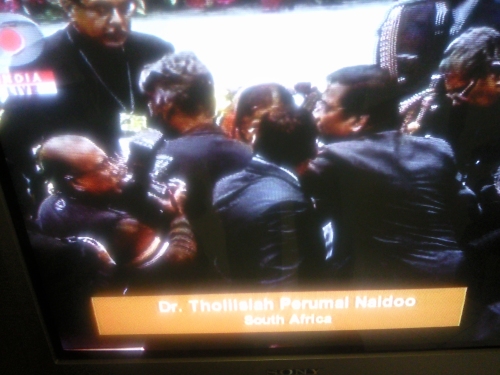 The President of the republic of India left the stage to come and honour Dr Naidoo ( of South Africa) on his seat during the Sanmaan.
The President of the republic of India left the stage to come and honour Dr Naidoo ( of South Africa) on his seat during the Sanmaan.
Posted in General, Uncategorized
New Year 2010 greetings
Happy New Year 2010
2009 is leaving and the New Year 2010 is at the door. Let us welcome 2010 with open arms and make a wish that it will be a better one and the whole world will work together to make it a better place to live.
The New Year 2010 has in store various things for different persons. We hope that it will be an eventful year with achievements and success in every field. We heartily wish that this year you will all achieve bigger goals and fulfill those commitments which were pending last year. Let us make this New Year 2010 more successful and joyful.
You will remember dear bloggers that this blog, was created last year during the Christmas time and it is fully one year now in operation thanks to your interest and participation. Hope you had a good time and informative items of your interest. We wish to improve and bring to you more interesting information that will be of interest to you.
Let me wish you all a Happy New Year 2010.
May everyday of the New Year shine with good cheer and happiness for you and your family.
Always remember that you need two wings to fly- the material as well as the spiritual. Both are needed for you to progress in life. With only one wing you will be only on the ground.
Posted in Uncategorized
Rise and Fall of Telugu in 21st Century
//
Telengana issue
Telugu people and Telugu land has had a long history of rise 
and fall of many kings and kingdoms and it continues to repeat
the same history again and again. After the formation of the
State of Andhra Pradesh, this State has achieved much success in many fields.
Now fate would have that it has to fall again for the pleasure and satisfaction of some people, who, despite speaking the same Andhra Basha, are resolved to fight and plunder to obtain a separate State of Telengana.
K Chandrashekar Rao (KCR) has attempted every possible gimmick to carve an image “Ultimate worrior of Telengana. To gain political mileage, TRS chief, Mr K. Chandrasekhar Rao, has threatened to go on a fast-unto-death if the Centre does not take steps to carve out a separate state from Andhra Pradesh by November 30. He in fact started his unlimited fasting unto death till the new State is formed. After eleven days of fasting and with the deterioration of his health the Central Government yielded to the pressure of the Telenganas to look into the issue of forming a new State again. What a daring decision? There is no leadership either in Andhra pradesh or India now. There is total confusion. And in the meantime the youngsters are plundering the property and wealth of all the private companies in Hyderabad. To whose advantage is it? The poor souls on the streets are the direct people to suffer in utter despair and the State is crumbling down.
Mr Rao has been championing the cause of a separate statehood demand since 2003.
About 70 out of 119 legislators from the region have already submitted their resignations.
Now in Hyderabad, tension is prevailing at Osmania University as police have arrested more students who had launched a hunger strike demanding that the central government immediately initiate the process for the formation of Telangana state by splitting Andhra Pradesh.
Police had a tough time removing six students and shifting them to hospital as hundreds of others resisted their attempts. These students had launched a ‘fast unto death’, hours after some of their colleagues on hunger strike were shifted to a hospital by police.
What will happen next? All Telugus around the world have their eyes fixed on Andhra now. How much they have invested? What will happen to their property now? There is no law and order. Who will save the mother land? A saviour has to come. Wait and see.
 OHM SHANTI
OHM SHANTI


Posted in Uncategorized
Proximity with a Spiritual Master
Proximity with a Spiritual Master
Since childhood I have always been questioning the meaning of this existence and the goal of life. I read most of the sacred scriptures of Hinduism, Buddhism, the Holy Bible and many other publications that relate the philosophy of life and existence. I was no doubt impressed by the revelations of Lord Krishna and Jesus – the Saviour. I was never convinced of the ritualistic systems of any religion. Religion has divided humanity. I came to know that religion has its limit. It cannot transcend its boundaries to reach the Divine. It can only put you in one of the path that leads to the Divine mansion and from there, spirituality guides you to the end until you merge in Divinity. We therefore see that many are guided to the path, but they get stuck there only without realizing that there is a Highway in front that will lead them to the real goal. They stop their journey at the doorsteps of a deity, a goddess or angel. God is beyond all that.
In the month of November 2009, I got a chance (I must say, a Divine call) to be with a Great Spiritual Master of this Age. In spite of short comings I fought against all evils to make my way, lots of obstacles, financial restraints, flu, fever, infections, weakness, frustration, but in end I overcome everything. I tried my best to reach there. It was in India – a remote region – far from Kolkata – famous city of Tagore, the Poet Laureate of India.
It was a village at the foot of a vast forest. From the Airport of Kolkata, I travelled in a beautiful air conditioned bus made to carry tourist, equipped with all new gadgets. But at last I was tired of travelling and felt exhausted. But in spite of all this, 3½ hrs of journey, I reached the place and a sign of relief dawned on my face. I was in a group of 24 Mauritians. Delegates from South Africa were also in the same bus. We all felt the relief. We got down and entered the centre. I was amazed and fill with joy to see a modern spiritual place. New buildings – Lecture Hall, Modern Library, Computer Room, Kitchen, Mess room, Dormitories, Cottage of Master, – all set up in a lovely and beautiful green environment of fauna and flora which I did not see on the journey from the Airport.
We went to the dormitories and got ourselves registered. We settled down in no time and I went to explore the place. It was a CREST (Centre for Research, Education and Spiritual Training). This Centre is built in a remote place at the foot of a forest where there is peace, tranquility and no human activity to disturb the searcher in his quest.
We were told that the Master would be joining the next day. We understood, a Master – a spiritual Master must be welcomed. We were all there the next morning to welcome the Grand Master. A smile on his face, he greeted us and looking a little tired after His travel, he proceeded to rest in his cottage.
I felt an electric current passing though my body the moment I came close to salute Him. This is the effect you get in the presence of a Spiritual Master of calibre.
Training sessions were held by the Master and His associates. Training was imparted mostly through meditation. No speech, no books, no notes, no pen and paper. He trains the Mind that helps to discover the Divine in us. He just closed His eyes and uttered “start meditation”. Everybody , pin dropped silence, sat there and started meditation. After one hour, He got up and left for His cottage. This exercise continued for eight days continuously.
Everybody present there were spell bound by the effect of the meditation sessions. I could hear words like love, surrender, trust, faith, devotion, cleaning, purification, prayer, transmission. All these words were items of daily conversation among brothers and sisters who attended the sessions. There was nothing of the mundane world. No mantra, no deity, no god or goddesses and no forms. “Pray to Him who is inside you. Connect to Him only. Try and try until you are connected. Your efforts will be compensated.” This was the whisper from the heart. Religions and rituals will never connect you with your Self that is inside you. They can connect you with material objects which are far from the Self.
When you realize the mistake, you find out that you have wasted your precious time and that you have no more time left and you have to leave this beautiful place. You regret that you have lost your chance. May be next time. Who knows?
On two occasions the Master also talked to us after the meditation sessions. His talk was convincing, pensive and illuminating. The substance of His talk was around – our duty, our behaviour in modern society, good character building. He also stressed the fact that we must forsake all negative tendencies, check our conditions both internal and external, get rid of our ego, forget our self importance, to be plain and simple, live in constant Divine thought and to follow the ten maxims of the mission.
I felt like staying there forever, listening to the lovely words of the master, but alas, the session was over after seven days and we had to return back home. Back to Mauritius, back to office and continue our daily activities again, of course this time in constant Divine remembrance.
In case you are interested to get more information about the
practice of this system of meditation and all details about the
Mission you can log on to this site, http://www.srcm.org
| Sahaj Marg Meditation | |
| Sahaj Marg translates to “The Natural Path.” It is a natural, simple
system of Raja Yoga meditation and spiritual practice that helps one realize the ultimate potential within oneself. Regular spiritual practice under capableguidance enables aspirants to progressively experience the sublime presence of the divine in their daily lives. The Sahaj Marg systemis freely offered to seekers worldwide through theShri Ram Chandra Mission (SRCM) under the guidance of currentliving Master, Parthasarathi Rajagopalachari, and is effectively practiced by individuals from all walks of life – diverse nationalities, religious backgrounds, and various social conditions. |
|
Posted in General
Andhra Day Celebrations in Mauritius
 Andhra Formation Day
Andhra Formation Day

Andhra Day is celebrated every year on 1st November in Andhra Pradesh as well as in Mauritius by the Telugus. It commemorates the struggle of those stalwarts who fought body and soul to obtain a common linguistic state for the 65 million Telugu speaking Andhras.
The first Andhra state with T.Prakaasam as chief minister and Kurnool as capital was inaugurated on October 1st 1953 by the first Indian Prime Minister, Pandit Nehru after India achieved Independence in 1947, and Vishaal Andhra (extended Andhra, i.e Andhra Pradesh) was formed on the 1st November 1956 with Hyderabad as Capital and the Nizam state included in the linguistic state.
The land of the Telugus was divided into bits and pieces like Rayalaseema, Andhra and Telengaana. By the patriotic labours of many Andhra leaders like Venkatapaiah, Gopala krishnayya, Tanguturi Prakasam, Kasinathuni Nageswara Rao, Pattabhi Sitaramayya and sacrifice of Potti Sriramulu, the Andhras were able to achieve their goal at last and obtain a state of their own, with all Telugu regions united on a linguistic basis.
The movement and struggle to obtain an Andhra state has a long history almost as long as that of the Freedom Movement which was started to obtain independence of India.
In Spite of the fact that the Indian National Congress was formed in 1885 and Freedom Struggle took a new dimension with the partition of Bengal in 1905, political awakening in Andhra came much later.
The Swadeshi Movement which started under the dynamic leadership of Surendranath Banerjee in Bengal became popular and it spread the ideas of Swaraj to every nook and corner of India. New leaders like Balagangadhar Tilak, Lala Lajpat Rai and Bipin Chandra Pal appeared on the national Scene. Vandemataram, the immortal hymn of the motherland was sung to inspire Indians to rise against the rulers. This movement received great impetus in Andhra when Bipin Chandra Pal toured Coastal Andhra in April 1907.
The Vandamataram and Swadeshi movements created among the Andhras a lively interest in their language, literature and their past history. Another landmark in the history of the Andhra movement was the publication of the book “ Andhrula Charitramu” ( History of the Andhras) in 1910 by the Vignaana Chandrika Mandali. This work became very popular and the Telugus became keenly aware of their contemporary backwardness. Although the Telugus represented 58% in the Madras Presidency, they had no effective voice in the politics of the region. Their intellectual attainment was nil and all educational institutions in the Andhra town like Bapatla, Machilipatnam, Rajamundry, Visakhapatnam etc, were headed by non-Telugus. Patriotic articles in the press contributed a lot to raise the opinions of the Andhras and to speed up the urge for sub-nationalism. Representations were made to the British government and grievances of the Telugus were exposed but as the British officers who ruled over the Andhras had very little knowledge of Telugu, many of their requests met with deaf ears. As a result of wide discussion in the press, the subject of the formation of a separate province came up for consideration in May 1912.
The first Andhra Conference with representatives from all the Telugu districts of the Madras Presidency met at Bapatla on 26 May 1913 under the presidentship of B. N. Sarma who was then a member of the legislative council of Madras.
The second Andhra Conference took place at Vijayawada on 11 April 1924 and henceforth the meeting became known as the Andhra Maha Sabha.
The Andhra Maha Sabha conferences succeeded one after the other each year but some Andhra leaders later diverted their attention to issues of national importance, like a United Congress, demand for Home rule etc. Demand for a separate Andhra province receded into the background. They gave priority to the nationalist movement. Their objective was that their motherland must be liberated from the British.
The Home Rule Movement subsequently gained momentum and Britain promised reforms of the impending constitutions. This was a great satisfaction to the Andhras and they keenly looked forward to an early formation of Andhra province.
The year 1919 saw the entry of Mahatma Gandhi into the arena of politics and marked an important landmark in the freedom struggle of India.
From 1921-1931, struggle in Andhra took a new dimension. During these years, the Andhras followed Gandhiji’ leadership heart and soul and made splendid sacrifices for the freedom of the country.
Inspired leadership was provided by eminent personalities like Venkatapaiah, Gopala krishnayya, Tanguturi Prakasam, Kasinathuni Nageswara Rao, Pattabhi Sitaramayya etc.
The Simon commission was set up to report on the reforms of the Constitution, but the Andhra Maha Sabha decided to boycott since no Indian was member of that commission. T. Prakasam took a leading part in getting the Andhras to boycott the visit of the Commission in Madras city. The police opened fire at the protesters in Parry’s Corner, the busy centre of the city, and a young volunteer died on the spot. The procession leaders asked the police officer to allow them to identify the victim. Pointing his rifle at the processionists, he threatened them with dire consequences, and none dared to approach the body. But one leader among them bravely unbuttoned his coat showing his chest before the rifleman and shouted: ”Shoot me”. Fearing fatal consequences, the police officer withdrew the rifle, whereupon a plethora of voices came from the crowd shouting loudly `Andhra Kesari ki Jai’. That was Tanguturi Prakasam Pantulu, who from then onwards came to be reverentially called ‘Andhra Kesari’ The brave and courageous march of Prakasam won him the title Andhra Kesari(Lion of Andhra).
The Andhra Maha sabha as early as 1931 at its first session demanded the creation of a separate university for Andhra as it felt that the Telugu language and literature was not receiving proper attention in the Madras University.
The controversy over the headquarters of the Andhra University created such ill-feelings between the Circars and Rayalaseema that it delayed the formation of Andhra province by several years.
Formation of Andhra State
When India attained independence on 15 August 1947 the Andhras hoped that their long cherished desire of a separate Andhra province would be fulfilled soon. Their optimism was based on the Congress election manifesto of 1946 wherein it was declared that the provinces of the country would have to be constituted as far as possible on the basis of language and culture. Many Andhra leaders like Prakasam and Ranga met Sardar Patel the Home Minister and Deputy Prime Minister, government of India, and requested him to see that the Andhra province was created before the new constitution was drafted. Patel promised to consider the legal implications. On 27 November 1947 Prime Minister Nehru announced that his government accepted the principle of linguistic provinces.
Dar Commission
June 1948 a commission was set up with S. K. Dar, a retired judge of the Allahabad High Court to report on the creation of new provinces, but this was a big deception. The report of the Commission created an uproar in Andhra.
Another committee was set up to look after the creation of linguistic provinces. The members were J. Nehru, V. Patel and Pattabhi Sitaramayya (J.V.P. committee). The committee submitted its report in April 1949. It recommended the formation of Andhra province provided that the Andhras gave up their claim to the city of Madras.
Later there was clash of personalities between Prakasam and Pattabhi who became Congress President in 1948. The new Constitution of India came into force on 26 January 1950. The creation of Andhra state was left to oblivion.
Swami Sitaram’s Fast
Swami Sitaram felt that he should adopt the Gandhian technique to achieve the Andhra state. So he began his fast unto death on Independence Day 1951. The fast created a highly explosive situation in Andhra. Thereupon Acharya Vinoba Bhave advised the Swami to give up his fast so that the whole issue could be settled in a peaceful atmosphere. The Swami ended the fast of 34 days on 20 September 1951. But nothing came up after that.

Potti Sriramulu’s fast & Formation of Andhra state.
The people expressed their resentment towards Congress in the general election of 1952. The Congress suffered massive lost of seats. The communists and the Kisan Majdur Praja Party (KMPP) of Prakasam formed themselves into a United Democratic Front (UDF). Prakasam was elected leader of the UDF which had the support of 164 members. The UDF was the largest single group in the assembly but the governor did not invite Prakasam to form the ministry. He nominated C. Rajagopalachary to form the ministry. After Rajagopalachary became Chief Minister of Madras, he tried to utilize his position to develop Tamilnadu at the expense of Andhra. Andhras were very wild against the behaviour of Rajagopalachary.
In such a situation Potti Sriamulu began his fast unto death on 19 October 1952 at Madras. When the fast entered its 50th day Nehru criticized it. Next day in the Rajya Sabhah he repeated the same old statement that the government of India will form Andhra state without Madras city, provided that there is general agreement among the parties concerned. Sriramulu was not prepared to accept Nehru’s statement and continued his fast. The fast created an explosive situation in Andhra and on the night of 15 Decemebr 1952 Sriramulu attained martyrdom. When the news of the passing away of Sriramulu was heard the entire Andhra region was swept in chaos. For three days, mobs raided railway stations and other government buildings. Police had to open fire and many persons died during the disturbances.
The disturbances opened the eyes of the Indian government and on 19th December Nehru announced in the Lok Sabha that the government had decided to form Andhra state excluding Madras city. After the announcement, location of the capital was a heated debate and it took some time to reach a decision. The capital was shifted to Kurnool.
Sanjiva Reddy could not form a government with his Congress delegates and enlisted the support of Prakasam to prevent the Communists from taking power. T. Prakasam became the first Chief Minister of the Andhra state and Sanjiva Reddy became the Deputy Chief Minister. On first October 1953 Nehru inaugurated the Andhra state.
T. Prakasam was the most popular Andhra leader, a great fighter, editor and political leader. The people of Andhra Pradesh had widespread admiration for him and were greatly inspired by his dauntless courage and sacrifice. The ‘lion of Andhra’ breathed his last on May 20, 1957, and the famous editor of ‘Andrha Prabha’, Narla Venkateswara Rao, commented: ”Andhra is bereft of light” (Prakasa viheenamaina Andhra). A grateful Government carved a new distrcit out of Nellore and Guntur and named it ‘Praksam’.
In Mauritius an effigy of Potti Sriramulu has been placed in the yard of the Mauritius Andhra Maha Sabha, and every year important personalities of Mauritius meet to garland the martyr. A cultural programme is also organized.
Sources: History of Andhra and The Hindu newspaper.
Posted in General
Sir Seewoosagur Ramgoolam (SSR) First Prime Minister of Mauritius
Sir Seewoosagur Ramgoolam (SSR)
(1900-1985)
Mauritius celebrated 109th birthday of SSR.
In this context the Mahatma Gandhi Institute organised a memorial lecture to commemorate this event. This article is a humble contribution on my part to inform our readers of an important part in the life of that great personality who later became the father of the nation of Mauritius.
First Prime Minister of Mauritius
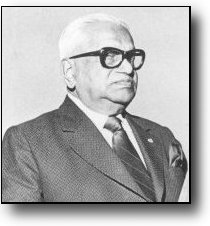

1. Birth and Childhood
The period during which Seewoosagur Ramgoolam was born was not a pleasant one. Mauritius was under British rule and French Barons dominated the scene. Indians and other communities were living in abject poverty. Some immigrants were brought to Mauritius from India during French rule. They were skill workers and artisans. But most of the Indians and Chinese came later were indentured labourers and a few came as traders. The Africans were brought here as slaves. They were dominated and treated like slaves and slavery was abolished in 1935.
Life of the indentured labourers was horrible. They had to toil night and day. Their lives were shortened with overwork. They had to wake up early every morning at four o’clock to work till very late in the evening.
Those who brought them on this island inflicted untold miseries on them. The children died young from diseases and lack of proper food. Almost all the men, women and children, young and old, had to toil in the scorching sun and heat in the fields. They lived in houses made of wood, straw and mud- a sort of small huts. They earned very little wages and had to struggle hard to maintain a family.
The white masters owned all the land and wealth of this country and the workers were kept in ignorance without any education. The land, sugar mills, banks, docks, big firms, the trade, all were in the hands of the whites. The planters were the French barons and they were the absolute masters. They controlled everything. They were themselves the lawyers, the magistrates, the judges, the doctors. They showed little respect for the Indian immigrants or their descendants.
The descendants of slaves and of Immigrants enjoyed no leisure. All weddings, festivals and ceremonies and other functions had to take place at night. Though everybody worked in the family, they did not earn enough. Wages were extremely low. Even the food ration of rice, dholl, salted fish and oil that were given to them were of bad quality. Their small huts were bare, without furniture. They slept on mats, cooked, ate and slept in the same dark huts, dimly-lit with an oil lamp. Conditions of living were intolerable.
These were the conditions when Seewoosagur Ramgoolam was born on 18 September 1900 in a small village in Belle Rive Sugar Estate. His father Moheeth Ramgoolam worked as indentured labourer and later rose to become a Sirdar (overseer) at La Queen Victoria Sugar Estate. When Moheeth got married to Basmati Ramchurn in 1898, he moved to Belle Rive S.E. Moheeth died young of pneumonia in 1907 and Basmati died two years later.
Later this child was called by the fond name of Kewal. Seewoosagur family lived in a hut among the estate houses. His father, Moheeth Ramgoolam was an Indian immigrant labourer. Seewoosagur grew up in the village of Belle Rive. Belle Rive village is situated at the feet of the Camisard mountain range approximately five miles away from Bel Air in the district of Flacq. This place is full of trees and forests. The Sugar Estate has planted clove and coffee in this region. Belle Rive had been part of Beau Champ Estate since 1885.
Moheeth Ramgoolam, came to Mauritius at the age of 18 in a ship called the Hindoostan in 1896. He had followed in the adventure of the other Indian immigrants. His elder brother, Ramlochurn, had left the home village of Hurgawo in Bihar in search of his fortune abroad. The immigrants were lured by all sorts of tales about life in Mauritius. Moheeth’s wife, Basmati Ramchurn, had two sons, Nuckchady Heeramun and Ramlall Ramchurn, by her first marriage. She was born in Mauritius.
At home, young Kewal was brought up in a family where he received all the love and affection. He grew up in a natural green environment, amidst plants, wild grass, flowers, trees, mountain and river. At the age of five, young Kewal was admitted to the local evening school of the locality, where children of the Hindu community learnt the vernacular language and glimpses of the Hindu culture.
This school is called the Baitka in the Mauritian Hindu term. The teacher (guruji) would teach prayers and songs. Sanskrit prayers and perennial values taken from sacred scriptures like the Vedas, the Ramayana, the Upanishads, and the Gita were also taught.
Many Indians avoided as much as possible the Roman Catholic schools. They feared that their children might slip into the grips of the Christians and would be converted into Christianity by the White masters.
But Kewal was not satisfied with a vernacular education only. He longed to have a taste of European education. So one fine morning, the small boy left in the company of his playmates to a school at a distance, just across the river, where a certain Madame Siris was the teacher. He did not inform his parents and his mother Basmati was very much worried. She searched for him everywhere in the neighbourhood but could not find him. She feared that young Kewal was lost somewhere. Her heart started beating very fast.
Then in the afternoon, she was surprised to see Kewal returning home from school, in the company of Madame Siris, who pleaded with Basmati to send Kewal to her school every day. Kewal had a very intense desire to learn.
The poor mother was relieved. She smiled and hugged her son. From that day Kewal went to the village school to learn the three R’s. Later, he joined the Bel Air Government school. He travelled by train every day to go to school and passed the Six Standard Examination without difficulty. During his school life he would also help his parents at home and in the fields and he accompanied his father Moheeth on the ox-cart in the neighbouring villages. He also went on errands for his mother.
As has been said earlier, the lives of labourers, particularly immigrant labourers, were horrifying. They died young, broken down with toil. Infant mortality rate was high. Basmati had lost two daughters. Kewal, the last child was lucky to be alive. There were many diseases. Diphtheria, anaemia, hookworm, malnutrition apart from occasional outbreaks of cholera played havoc among the peasant folks. There was no basic sanitation. The poor had to consume unhealthy water from rivers or from wells. Pure tap water was available only to be the privileged class inhabiting Plaines Wilhems. Medical and sanitary facilities were restricted to people living in the urban region only.
Kewal was still a child of seven living in Belle Rive, when his father Moheeth, died of pneumonia. He was brought up under the care of his step- brother Ramlall Ramchurn.
Ramlall Ramchurn, the step-brother of Kewal, was twenty-one years old when Moheeth passed away. He worked as tally-keeper (marqueur) at Belle Rive. His duty was to take the attendance of the workers, and record the number of cartloads of cane brought by them. He also enjoyed many privileges because he was trusted by the estate owners and he was an intelligent person in the village. He later became a small planter, with his property at Belle Rose, Clémencia.
Ramlall had great love and affection for his young brother Kewal. When he got married he took Kewal under his charge. When Kewal was twelve years old, he met with a very serious accident. His brother Ramlall was not at home and Kewal wanted to help the workers by removing the ox from the cowshed and harnessing it to the cart. He walked slowly into the dark, smelly shed, and moved courageously towards the ox. There were flies buzzing around everywhere. He took a rope to tie on the neck of the ox so that he could pull the animal to the cart. But he was not that lucky. The ox then moved its head to drive away the flies and in the process hit the small boy with its horn on the left eye.
At that time, Ramlall was not at home. He was out on his way to collect the wages of the workers and had gone to the Mauritius Commercial Bank which was in Port Louis, the capital of Mauritius. He also gave instruction to the workers to bring guano(fertilizer) to the field. And this instruction everybody at home had heard, including young Kewal. That was why he wanted to help the workers, but unfortunately that accident occurred. Kewal screamed in pain and soon his face was bathed in blood and he fainted. His sister-in-law came running and in panic asked the workers to go and fetch Ramlall who was still at the railway station at Rivière Sèche.
Ramlall was very upset. He brought Kewal for first care to the single-room hospital of Belle Rive Estate hospital where the dresser gave him some first aid treatment. He then took him to Beauchamp hospital where he stayed for four weeks. In spite of all the care and tenderness of Ramlall, he could not get any of the doctors in those harsh days to save Kewal’s eye. Medical facilities were very limited and mostly unavailable to the poor.
After this accident, Kewal was then admitted to a school in Curepipe. Ramlall knew the value of education. He wanted to give the best education to his brother, who was a very hardworking child. Ramlall sent his brother to attend scholarship class at the Curepipe Boy’s Government School. Kewal had an uncle living in Curepipe. His name was Harry Parsad Seewoodharry Buguth. He was a sworn land surveyor and Kewal stayed there at his place and attended the school. He later won a scholarship and joined the Royal College of Curepipe.
The Royal College was then the only State Secondary School in those days and very few children of Indian origin attended this school. Indians did not want their children to attend the missionary schools fearing that their children could get converted to Christianity.
The Royal College was a model of the English grammar school and it gave education and training to many of the future leaders, professionals and administrators of Mauritius.
To continue….
Posted in Uncategorized
1932-Andhras in Mauritius


1932—The critical situation of Andhras in Mauritius.
(Source: ‘Indians in Mauritius”)
This article must be of special interest to all Andhras. It tries to give the details of Andhra life in Mauritius. As observed by Mr Pydayya earlier, the Indian population in this island in 1930 was about 280,000 consisting of North Indians, Andhras, Tamils, etc. Unfortunately, there was no statistics showing the composition of Indian population according to provinces or communities. But the following estimate was not far from correct: North Indians (105,998), Andhras (55,000), Tamils (50,000), Muslims (47,000), Marathas and Bengalis (23,000), totaling 280,000.
The author recalled that in his letters to the Trilinga and the Andhra Patrika in 1929, he depended for his figures on the 1929 census, he gave the total Indian population as 265,000. He also divided the figure as follows: North Indians 90,000, Andhras 55,000; Tamils 50,000, Muslims 47,000 and Marathas and Bengalis 23,000. In order to discover the name of the first Andhra immigrant and the year, he looked forward to the assistance of Mr. Rajabally, Assistant Protector of Immigrants. But did not succeed. He relied mainly on a few Andhras who were born on the island who were 60 or 70 years old, he even concluded that their first batch might have arrived here in around 1860. (First batch of Andhra immigrants arrived in 1935). The country’s non-Andhras generally called them Coringees, whereas, the knowledgeable ones called them Telugus. The Andhras resented being called Coringees, a pejorative term, reminding them of indenture which has long been abolished. (The first batch of Indian emigrants of Telugu origin hailed from the then port of Corringa, in the coast of Andhra Pradesh which was later destroyed by a severe tidal waves and left to oblivion). Sri Narasimha Dass and Appalasami Jogannah held several protest meetings on this point and it was to be expected that with more propaganda, the word Coringee would have a decent burial. Similarly, the North Indians and others were once called Malabaris; but as a result of strong protest, this pejorative term has almost disappeared.
Like the other Indians, the Andhras were widely scattered in the island. Very few lived in towns like Port-Louis while some hundreds inhabited the villages. The bulk of the Andhras resided on sugar estates. In towns, they were traders or domestic servants. In villages, they were peasant-proprietors or agricultural labourers. On sugar estates, they constructed houses for themselves or for tenants, stables for cows or bullocks and even own bullock carts for conveying sugar-cane to the Factory. Cane was sold either directly to the factory-owner or to traders on contract, be they Indians or not. There were also Andhras living on sugar estates as labourers, mill-drivers, boilers, sirdars, etc. The working conditions, status and treatment of the Andhras did not differ from those of the others.


Though the Andhras had been at that time living in Mauritius for nearly half a century, it was unfortunate that there was not a single school where Telugu was taught. Night schools were often set up to teach up to the stage of Pedda Balasiksha but they closed down as soon as the course was over. The teachers were not qualified, as they had, but a smattering of Telugu only. The mother tongue was not properly preserved. The object in learning it was merely to be able to take part in Bhajans or Telugu satakams. Large Telugu schools were not possible, for most of the Andhras prefered their children to be taught either English or French so that they might easily get jobs. The vernacular was studied only for the sake of being able to read the sacred books, etc. At the age of six, Andhra children attended the government primary schools where English and French were taught to all pupils till Standard VI. Then the Standard VI certificate was granted to them. Formerly it used to enable them to get jobs easily. But in later years, unemployment among the educated became so rife that thousands of Standard VI certificate holders were roaming about for want of jobs. Most of the Andhras being poor read only up to Standard VI, though a few read up to Senior Cambridge. A few of the certificate holders however were employed as tailors, traders, domestic servants, etc.
Very few Andhras could go to the Royal College: Among them are:- Seetharamdu Nirsimloo, Venkateswarulu Nirsimloo, Brahmadoo Nirsimloo, Parshottam Nursayya, Balachandra Joganna, Balasoobrayudu Naidoo, Pyndaya Lutchmayya, Sunnassee Lutchmayya, Appannah Lutchmayya and Dr. Lutchmayya. The four Lutchmayya brothers were the first to enter the Alma mater and they were very intelligent and influential. All of them occupied high posts in the Government service. Mr. Pyndayah Lutchmayya was for a long time the Chief Interpreter to the Supreme Court. On leaving Government service, he took up the work of developing co-operative credit societies among the Indians. He visited England and India to study the co-operative movement. Two other Lutchmayya brothers were employed as chief clerks in two important departments of government while the last brother Dr. Lutchmayya was for some time a civil servant, after studies in France, he returned to Mauritius in 1927, but went to France in 1929. Though the brothers became Protestant Christians, they were all very sympathetic to the Andhras.
In 1927 some educated Andhras formed an association by name of the“Mauritius Telugu Association” for the uplift of the local Andhras. The first meeting was held in Rose Hill and soon about 100 members joined. But it had soon to dissolve as its Hindu and Christian members could not get on in social and religious matters, though the number of the latter was not large. Subsequently, all the Hindu members of the Association formed the “Mauritius Andhra Maha Sabha” as initiated by Narasimha Dass and Ramasawmi Pydayya.
Andhras are employed in various capacities, as station masters and head teachers. The post of “marker”(Time keeper) on sugar estates and of sirdars was mostly offered to Andhras who had also among them a number of planters. In those days, Sri Cotapah Nirsimloo was the richest Andhra in the country. But untill 1925, Sri Venkatasawmy Ramayya was richer than him. In that year, however, the sudden fall of prices in sugar completely ruined him. He died in 1930. His son Parshotamah Ramayya later joined government service. Sri V. Ramayya was well known for his charity. The name of Sri Rajgiri Narasimha Dass was also well known. This gentleman, was a scholar in Hindi and Telugu besides knowing English and French. When 18 years ago, Manilal Doctor came to work for Indians, he chose Mr. Narasimha Dass as his assistant and entrusted him with the editorship of the paper “Hindustani”. It had soon to be closed down however, but previously, it had a good name. Mr. Narasimha Dass had a good reputation as a scholar. On the occasion of Sastraths held formerly between Arya Samajists and Sanatanists, Mr. Dass used to be the spokesman for the latter but such occasions to-day are rare. Whenever a “Bhagavat Katha” or a “Valmiki Katha” is organized, Mr. Dasswas always invited. He had two sons and seven daughters and was devoting all his time to the preparation of Telugu books on religious subjects. Mr. Chattapilli Appalsami Jogannah’s name was very closely associated with the construction of a temple known as the “Vishnu Mandir” at St. Pierre. The anniversary of the temple was regularly celebrated with pomp and many non-Andhras and non-Indians also tok part. Mr. Joganna’s son, Balachandra, formed a Sabha at St. Pierre known as the Janananda Sabha. He visited India in 1926, his photograph appearing in the Telugu Samachar.
The name of Sitannah Appadu was well known here in connection with the Andhra Mandir at Beau Vallon, the first anniversary of which was celebrated in 1926. Sri S. Ramajogy sirdar and Rajgiri Naidoo Parsooram were also well known. They were both employed here as the chief Sirdar and a writer(marker) on the Beau-Champ Estate and enjoyed great influence. They were empowered to call a meeting of all the Andhra labourers on the estate and to submit any quarrels for its decision which was to be final. But if a member did not abide by the decision and went to the police he would be removed from the estate. Such a meeting was known as the Panchayat Sabha. North Indians had their own Sabha. Sri Rajgiri Naidoo Parsooram was a nephew of Narasimha Dass and was sub-editor of the “Hindustani”. Sri Brahmadoo Nirsimloo was also well known. His father, a very religious old man, died i n1931, at the great age of 90. It would be tedious and invidious to mention the names of all other Andhras who were in some way prominent. But mention must be made of Kistamah Kamayya who was the Secretary of the Hindu Benevolent Society and the President and Vice-President respectively of a benevolent society in Curepipe.
The Andhras on sugar estates generally performed Natakams during the New Year holidays which they got from the 1st January to the 7th every year. The Natakams organized are Rama Natakam, Virabhadra Natakam, Mayala Ravana Natakam etc. Later, the practice of organizing singing parties with harmonium, tabla, etc. was getting common. But many Andhras were following the tenets of the North Indians and the Tamils. The common festivals observed are Krishna Janmasthami, Ramnavami, Deepavali, etc.; but these were celebrated with greater pomp by the North Indians than by the Andhras. Andhra marriages here were officiated by North Indian Brahmins who were locally known as Culcatteea Brahmins. But the “Vidhi” (the rites and ceremonies) followed was strictly Andhra. Hindu marriages take place generally at night, except among the Tamils and the Arya Samajists who celebrated them during the day. The marriageable age was generally above 14 for girls and above 20 for boys. Caste restrictions were generally observed for marriage, but eating and social intercourse were not caste-confined. Till 1926, an Andhra gentleman was officiating as the priest in Andhra marriages but in that year itself he died.
The general language used by the Andhras was Hindi, though they understood Telugu. The reason was that the number of North Indians was very large, and their influence therefore great. The common language of the island, however, was (and is still) the Creole language which was understood by all and was used in government offices, commercial offices, etc. It appeared to be the original French language as spoken by the French to their slaves and labourers. It was a matter for gratification that Andhra women wore their traditional dress and ornaments, as the Tamils do. The men, especially of the younger generation, wore coats and trousers. The head dress was either a turban or hat or a big handkerchief. A large number of the North Indian women wore gowns; but Telugu, Tamil and Marathi women wore the sarees. Andhras in government employment or working in other offices wore European dress, but others wore the usual dhoti, shirt coat and turban. The bulk of the Muslims here wore coats, trousers and Mohamedan caps. As for their women, very few indeed observed gosha (a sort of dress called Burkha to cover the face and the body).
The Arya Samaj was doing some conversion work and it has a large body of sympathizers among the Andhras. It had also trained two preachers who went about the country and preached especially among the Andhras. As it is, the Andhras were like a flock of sheep without a shepherd.

Comment: 1
Article: 1932 Andhras in Mauritius.
An eye opening piece. Fortunately,we are no longer sheep without a shepherd these days.
Currently we seem to have a mixture of leaders, cultural, spiritual and political. They all appear to be speaking in the name of the Telugu Community.If they are working towards a common cause,well and good.We need a coordinated leadership to guide us to specific goals.Put aside personal issues and conflicts if there are any and work for the common good of the people with regard to our language, culture and art within a national frame. We have many more highly intellectual brothers and sisters among the Telugus today in all walks of life.I am sure they will work hard and selflessly to keep the Torch of Andhraism burning brightly;otherwise the cause for which Sri Potti Sriramulu died would be worthless.
Recently we mourned the untimely demise of a great Andhra leader,YSR.Let’s be inspired by him too.We have an important role to play in the continuing development of Mauritius in all areas.
We must speak with one powerful voice,the voice of a community being led with a proper vision.
Although not in the country,which I visit regularly I do take a very keen interest in the progress and development of the Andhras no matter what religious denominations they may belong to.
I commend the book,Indians in Mauritius,to all as a valuable piece of rsearch into our history.
Dr Bala D.Lingiah
Glasgow
Recently we mourned the untimely demise of a great Andhra leader,YSR.Let’s be inspired by him too.We have an important role to play in the continuing development of Mauritius in all areas.
We must speak with one powerful voice,the voice of a community being led with a proper vision.
Dr Bala D.Lingiah
Glasgow
Posted in General
Indians in Mauritius
Indians in Mauritius
First book written in English about Indians in Mauritius.
This book was written by Mr KR Pydayya, a Mauritian Indian in 1932 and published by Ramaswamy Sastrulu & Sons, Madras in 1936.
It is edited by Dr G Reddy Luthmoodoo and reprinted in New Delhi by the Star Publication. It will be launched on Saturday 29 August 2009 at 1500 hrs at the Municipality of RoseHill in collaboration with the ODI organisation(Mauritius)

The author’s intention was to give a true picture of the social condition f the Andhras in Mauritius during his lifetime in 1930, but instead, he landed up by writing about all the Indians in Mauritius. A unique piece of information to historians and research scholars.
“Indians in Mauritius” was written by Kalla Ramaswamy Pydayya and published in 1932 in Madras, India by V. Ramasawmy Sastrulu and Sons. The first edition of this book had 120 pages with ten chapters.
During colonial period, publications by Mauritian authors were very few or inexistent. Indians who migrated to this island had a very tough time and they had to endure a lot of hardship to survive. Some inhabitants who could afford to help did not spare any moment to help in whatever way they could. Some offered their help as social workers and others joined politics and a few contributed their lot by raising public opinion in the press, be it in Mauritius or abroad. Mr Kalla Ramaswamy Pydayya was one such patriot who tried hard to uplift the social status of many Indians and the Andhras in particular. He was an ardent social worker and tried his level best to bring the Telugu community together to form an organization known today as the Mauritius Andhra Maha Sabha, situated in Port-Louis. Moreover he has been President and Vice President of this association many times.
The author’s intention was to give a true picture of the social condition of the Andhras in Mauritius, but since he did not have enough materials to write a whole book on the Andhras he decided to write on the situation of the Indians in general. He wanted to bring to light the condition of Andhras in Mauritius and to make the people of India acquainted with the life, conditions and difficulties of Indians in Mauritius and he continuously harped upon the demand for Andhra religious missionaries to come and guide the Andhra Community in Mauritius.
He wrote and published “Indians in Mauritius” in 1932, but it seems that this work has gone unnoticed by many historians and researchers. Our intention of bringing a second edition is just to make public what has been so long left in oblivion. It is surprising to see even Aunauth Beejadhur who wrote “LES INDIENS A L’ILE MAURICE”, in 1935, a French publication, did not mention about this author in spite of the fact that he mentioned his name in his book on page 86 as somebody who helped M.J. Wilberforce to establish the Co-operative movement in Mauritius.
In the preface, the author pointed out that he tried to give a faithful picture of the social, intellectual, political and economic conditions of the thousands of Andhras domiciled in Mauritius, at that time, a colony of the British Empire.
He had good relationship with my many stalwarts in the political field of his time. He was a good friend of the father of the nation Sir Seewoosagar Ramgoolam and others in Labour Party.
The book reflects the true experiences of the author who was no expert in the field, yet he wrote on the conditions prevailing in those days. He wrote about the island itself, its population, the planters, religion, the Indians and their occupations, the Andhra community, the constitution of Mauritius, the cyclone of 1931, the financial commission of 1931 etc. It appears that he could not lay hands on primary sources to justify many of his views as there were not sufficient records available to him but he strived hard to meet some officials and gathered enough information to give, as far as possible, a true picture of that time. Some of his letters written to the colonial secretary of that time and officers of the British colony show some of his attempts made in this direction.
In this second edition, a few changes have been brought for better understanding. The number of chapters which was initially ten has been extended to thirteen. Names of persons which were wrongly written have been corrected and a few minor modifications have been made to give a clearer picture of the intention of the author.
A few friends and well wishes have helped in the editing of this material. I would place on records the help of Chit Dukhira, Mythil Benymando, and Narain Ramana.
This second edition has been made possible thanks to the generosity of Viswam Pydiah , son of Mr Kalla Ramasawmy Pydayya.
Dr Reddy Luthmoodoo
For copies kindly write to Dr Reddy.
or mail grlmgi@yahoo.com
Mauritius


Posted in General





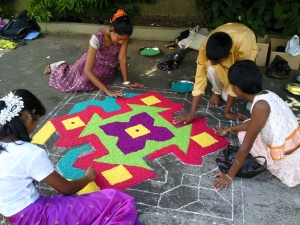


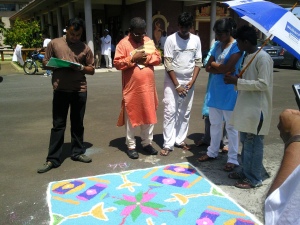
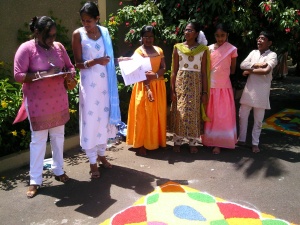
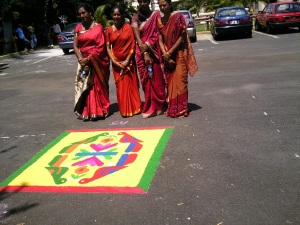
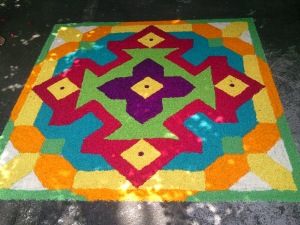















Latest Comments